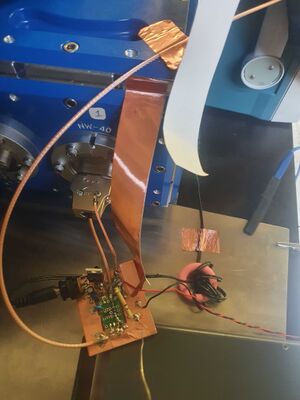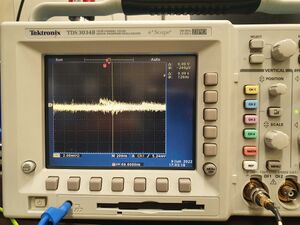Status updates
Update 15/11/22
The readout board and amplifier
Update 6/10/22
The pre-amp noise is not coming from the power source, as previously thought. It is noise picked up from the environment. Putting the readout board in a metal casing would help to reduce this noise.
Update 5/10/22
Hans from the electronics department has built a more professional version of our small readout board. The schematic is shown on the previous page. This readout board contains several features which are summarised again here for clarity. The bias supply is implemented through this board via the red and black cables seen on the right hand side. These supply the 56V bias to the SiPM from a basic power supply which is connected to the ground. The SiPM signal is then fed through the golden cable into the feedthrough and to the SiPM. The signal is read out through this same cable and fed onto the board. The board passes this through a high-pass filter to eliminate noise with low frequencies and into the pre-amp. The high-pass filter and pre-amp both rely on the feedback resistor to set their values. This is easily modifiable by changing out the resistor. Currently, the pre-amp only multiplies the signal by a factor of 1. The pre-amp is powered through a normal mains outlet which is passed through a Ferrite bead (seen in pink) before the connection. In order to ground this supply, an extra plug is placed in the outlet used and connected to the metal sheet resting on the table. This is the common ground used for all parts of the readout. To keep this common ground, the same outlet is also used for all plugs used to power components. To reduce noise from the setup, copper tape is used to connect the chamber, board and ground plate, and the two sections of the table which were found to also be producing noise.
This readout system allows peaks of ~1mV to be seen on the oscilloscope (also connected to the common ground). The amplifier is still producing noise roughly 2mV in height. This noise is regular so it is possible to subtract this from the signals in analysis but we will still look at removing it manually.
This readout was connected up to the chamber. A new connector plug was built with permanent connection of the SiPM bias/signal wires to their correct feedthrough positions. This prevents finicky work inside the chamber for longer periods of time. The anode wire for the SiPM is connected to the wire marked with kapton tape and the cathode to the bare wire. After tightening the wires, this doesn't introduce any noticeable noise into the system. They were also cleaned with isopropanol before insertion.
The VUV-sensitive SiPM 1828 was connected and the chamber and closed up. In a dark environment, the noise from the pre-amp is present but SiPM signals are still clearly visible underneath this. These signals peak at ~1mV, indicating they are single-PE signals and there weren't many noticeable larger SiPM signals to indicate multiple-PE signals were present. Though there is still a small light leak, this is reduced. There is also a small vacuum leak which is expected to be in the same location. We can hence confirm that the light leak that was present before the cleaning is no longer such a problem. This was probably fixed by tightening the connections around the chamber.
The lamp fan was moved to the same outlet as the readout electronics and switched on to determine whether the noise that was present from this source was still a problem for the readout. The fan introduced no new noise so either the noise was solved through common grounding or moving the cables may have eliminated it. Switching on the lamp with the slits closed also introduced no new noise or significantly more multiple-PE signals.
The chamber was pumped down with the cables and SiPMs inside to determine their effect on the vacuum and the vacuum's effect on the signals. Minimum operating pressure of 10^-3mbar was reached without issue within 30 minutes. Wiping the cables with isopropanol is fine for now to keep a clean enough environment for the pump. The vacuum pump exacerbated the noise from the pre-amp a little when turned on. This may be due to the vibrations of the pump on the table itself which moves some wires. There are some interesting-shaped signals when the pump is still ramping up to 1500Hz, but this is not a problem for the signal readouts afterwards.
The pre-amp is currently not producing any amplification of the signal. This is adjustable through the resistor values which still need to be balanced, and an amplifier board will also be connected. This resistor is placed in a feedback position in order to control this amplification. However, the amplification currently acts on the current, which is later converted into a voltage signal. The Zurich group have sent us a spare board from their setup which utilizes a transimpedence amplifier. This works by converting the signal first into a voltage output and then amplifying it. A drawback is that it also flips the signal to a negative pulse. This should not be an issue as the digitiser ordered should be able to handle both positive and negative pulses. If it does matter, however, it is simple to flip the signal again to create positive pulses. This will be investigated in future, but for now, there is an observable single-PE signal from inside the vacuum with the lamp on and slits closed.

